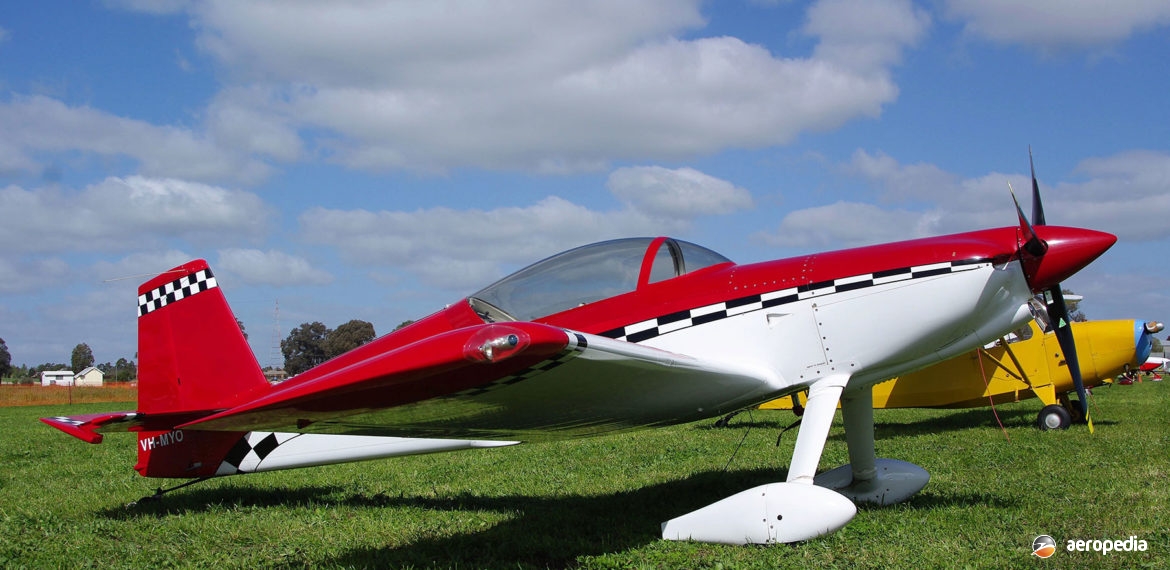Photograph:
Team F-1 Rocket VH-MYO (c/n 069) at Cowra, NSW in September 2010 (David C Eyre)
Country of origin:
United States of America
Description:
Two-seat light sport monoplane
Power Plant:
One 186 kw (250 hp) Lycoming IO-540 six-cylinder horizontally-opposed air-cooled engine
Specifications:
- Wingspan: 6.67 m (21 ft 10 in)
- Length: 6.40 m (21 ft)
- Height: 1.73 m (5 ft 7 in)
- Wing area: 9.66 m² (104 sq ft)
- Max speed: 443 km/h (275 mph)
- Cruising speed at 75% power: 370 km/h (230 mph)
- Cruising speed at 60% power at 3,048 m (10,000 ft): 370 km/h (230 mph)
- Stalling speed: 87 km/h (54 mph)
- Rate of climb at sea level: 945 m/min (3,100 ft/min)
- Take-off distance: 91 m (300 ft)
- Landing distance: 213 m (700 ft)
- Range cruising at 55% power: 1,609 km (1,000 miles)
- Fuel capacity: 159 litres (35 imp gals)
- Empty weight: 516 kg (1,138 lb)
- Useful load: 292 kg (643 lb)
- Loaded weight: 808 kg (1,781 lb)
History:
The Team Rocket is a light high-performance kit-built monoplane produced by Team Aircraft of Taylor, Texas. It is a sport monoplane designed in the Czech Republic by International High Performance Aircraft and has been marketed by Team Rocket in Texas, USA in kit form. It is advertised as an “all-metal airframe crafted and designed for the discriminating pilot that seeks F-16 like performance at an affordable price. If you enjoy the thrill of blasting off with a 3,500 fpm climb and levelling off at 10,000 ft five minutes later for a 230+ mph cruise”.
Some 175 kits were produced in the Czech Republic and production then ceased. Thereafter it has been produced in the United States, Frazier Aviation of Indiana producing kits under licence in two models, the F-1 Rocket with either the IO-540 or IO-550 six-cylinder engine; and the F-4, being a two-seat variant with a four-cylinder Lycoming engine. The type is available either as a quick-build kit or a Parts Kit, the builder being able to purchase sections to spread the cost out over the time of construction. However, major parts of the aircraft are still constructed in the Czech Republic.
It is a two-seat low-wing monoplane built of aluminium with a fixed tailwheel undercarriage and can be fitted with engines in the 175 kw to 224 kw (235 hp to 300 hp) range driving a three-blade propeller but the aircraft is usually powered by a Lycoming IO-540 engine. A tailwheel type undercarriage is usually fitted.
The prototype first flew in the United States in November 2000 and since then more than 100 examples have been completed around the world. It is known under a number of designations around the world, some examples built in the United Kingdom being known as the Harmon F-1 Rocket, named after one of the first British kit builders.
Variants of the Vans RV-4 were developed by John Harmon and were known as the Harmon Rocket II and the Rocket III. In his designs he modified a Vans RV-4 and fitted it with a 134 kw (180 hp) Lycoming O-360 engine. Harmon then developed the Rocket II which could take engines in the 96 to 134 kw (125 to 180 hp) range and was capable of some aerobatics. It was not sold in kit form as such but parts were sold as a kit to modify an RV-4. The Rocket III was a single-seat model using the RV-4 / Rocket II as its base with modifications including shortening the wings, the engine being the IO-540 in modified form producing up to 298 kw (400 hp).
The first example completed in Queensland was VH-DUG (c/n Fl.0012) registered in 2002 as a Watson F-1 Rocket. Further examples include VH-DAT (c/n 135T) in 2004 at Geraldton, WA, VH-FLY (c/n 106) in March 2005 in the ACT, and VH-MYO (c/n 069) registered to Kennedy Aviation of Gunnedah, NSW on 15 August 2017. One example has been built by Russel McFarland of Newcastle, NSW and has been fitted with a turbo-charged Mazda 13B aluminium engine. Another became VH-FVO (c/n T-169) on 19 September 2013 but on 1 November 2019 was exported to the United States as N30ER.
First completed in New Zealand became ZK-RMD (c/n HR2-187-08) to its owner in Auckland in March 2008.

